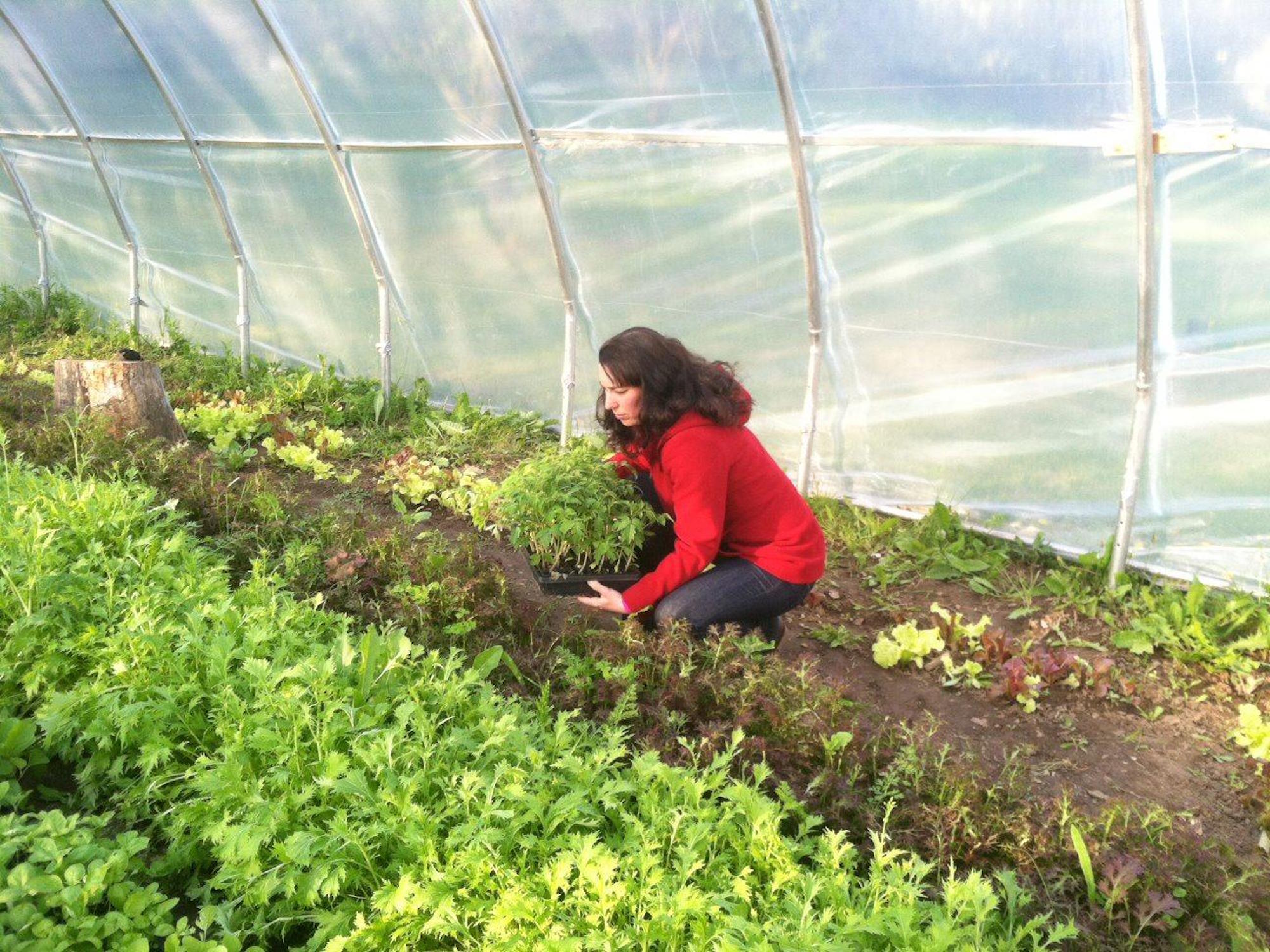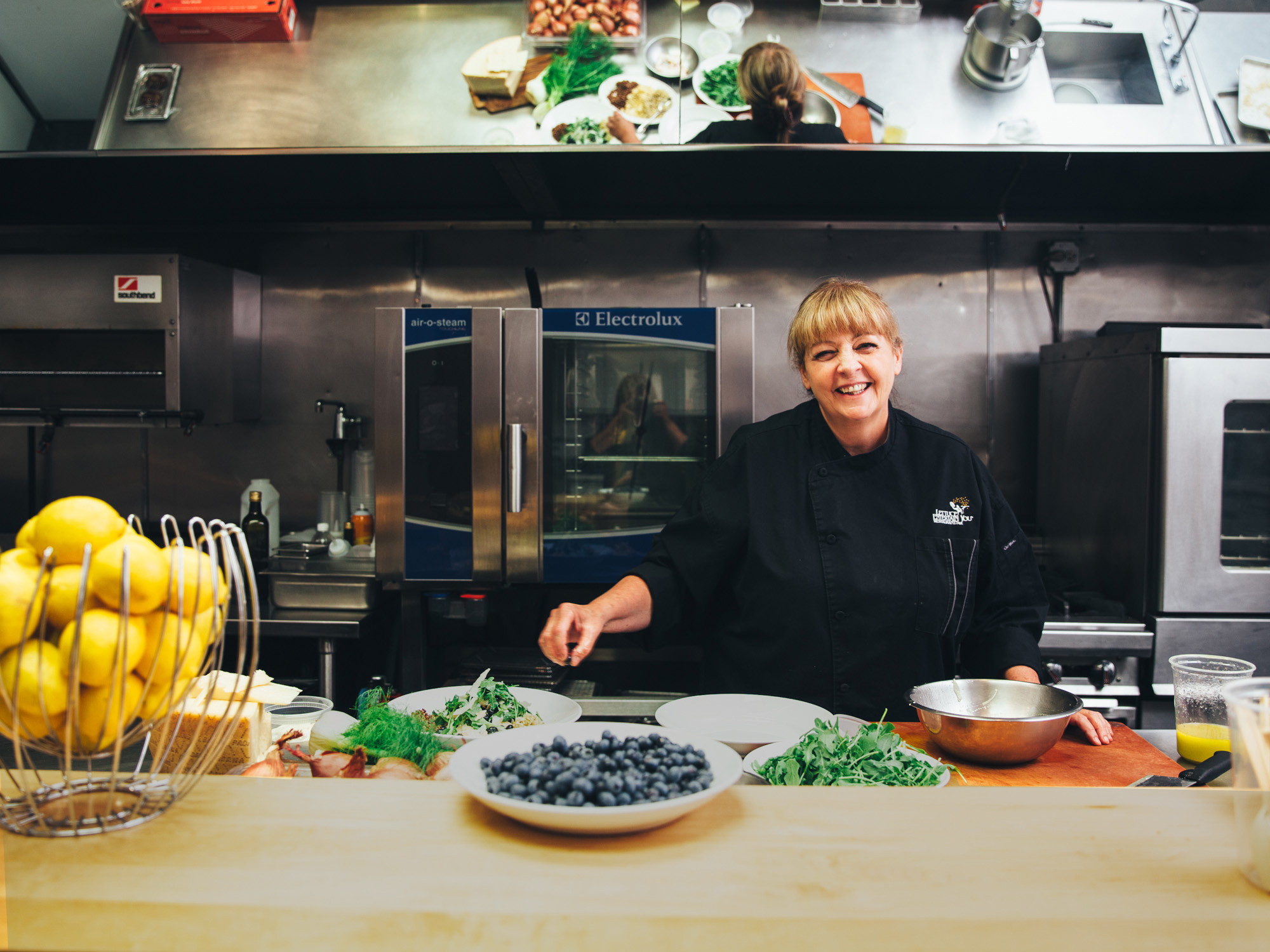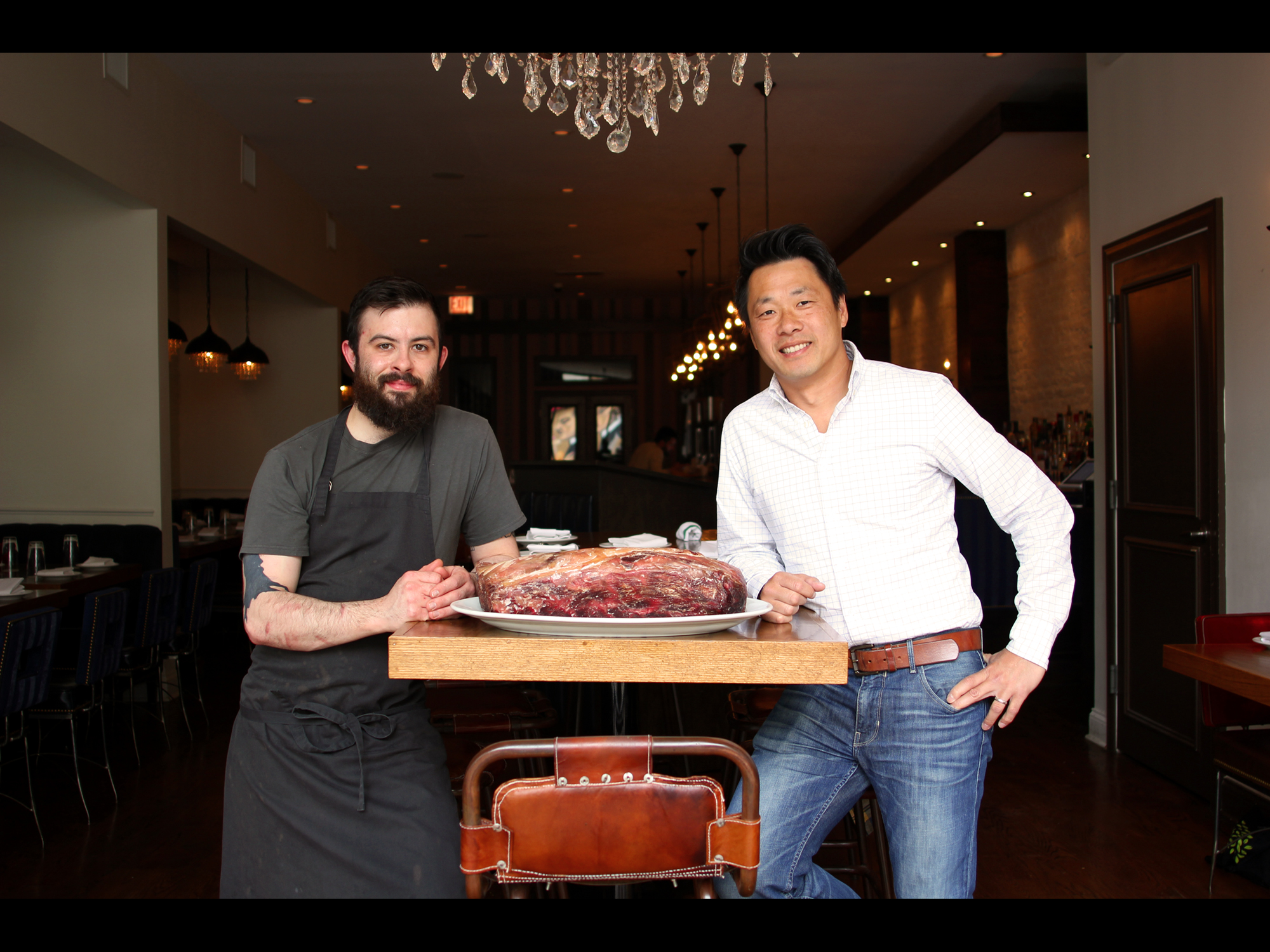THE OFFICES OF SANCERRE HOSPITALITY are as nondescript as newly-moved-into offices can be—white walls, black chairs, gray sweatshirts on the 4 or 5 people sitting in front of rectangular screens. The real vision of this new company is outside—in all the hot restaurants that they hope to take their place among. Grace is next door. Girl & the Goat, Au Cheval, Bad Hunter, the newly opened Ronero are just down Randolph. And the way they describe their restaurant’s location is “across from Momotaro.”
By summer they hope to have BLVD, their first restaurant, open in this neighborhood and making a splash with a 1950s Hollywood glamour theme designed by Karen Herold (Balena, Embeya), while for a chef they went to the nearest thing to old Hollywood in real life, hiring away Pump Room chef Ross Mendoza. After that, who knows where they’ll go? But they have to make the first one work, first.
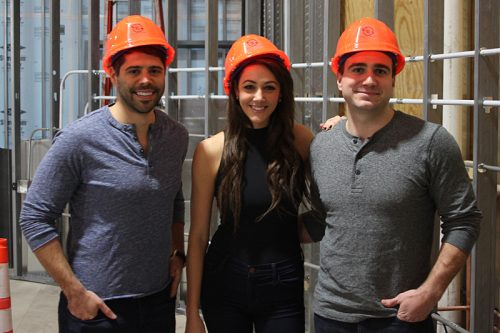
Frank Callero. Kara Callero, and Steve Zaleski at BLVD. as it looked in mid-February
I met with the three partners—Kara Callero, who comes from hospitality (and worked most recently for the PR firm Wagstaff), her husband Frank Callero, a real estate attorney, and his cousin Steve Zaleski, who also comes out of real estate development and investment. The way they talk about it now is very much their ideals, their aspirations—they’ll talk about it very differently once they’re running a restaurant, I’m sure. But in a few years, if people are talking about Sancerre restaurants like they do Boka or Hogsalt, here’s who they were and how they got into it, back in 2017.
FOODITOR: Let’s start by telling me your pitch for BLVD. Like I’m an important guy with money to burn.
KARA: The name is “boulevard,” spelled BLVD. It’s inspired by Sunset Boulevard in the 1950s, and we’re really kind of drawing from that old Hollywood glamour, sophistication, timelessness, and luxury. But we’re kind of bringing that back into the modern world with the food we’ll serve, with the music—you’ll hear maybe Frank Ocean, not Frank Sinatra—but we think that that juxtaposition between old and new, then and now, will be fun and interesting and speaks to us a little bit.
Generally we can say that it’s modern American food, primarily shareable plate concepts. We’re going to be making kind of classic dishes, with flavors pulling from different cultures, pulling from the 50s a little bit, but flipping that on its head and making it a little more contemporary, inventive.
FRANK: And I think one of the things about being in the West Loop is that you see a lot of exposed brick, more industrial style buildings, and with this concept we ended up going more for a finished feel. And that was something that ultimately became important to us, to set ourselves apart from some of the other restaurants in the neighborhood. But to Kara’s point, having that meatpacking district vibe going on on the exterior, creates that cool juxtaposition when you enter the space and have that more contemporary, kind of finished feel.
The other thing we can say on the food is, from a shareable plate perspective, going that route on the food versus the traditional appetizer-entree-dessert was important to the concept, again, because of creating that experience. We love the idea of having everyone sharing the plates, and talking about the food, and helping along the conversation at dinner. To us, creating that social environment is super important and will bring a lot of life into the space as well.
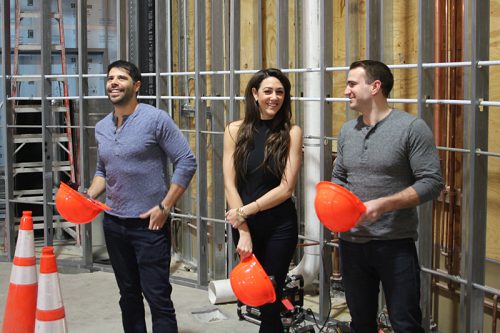
Tell me about deciding to open in this neighborhood, which is so hot for restaurants, but also so expensive and such a gamble.
FRANK: I don’t think we’re mind readers in the real estate world, but I think as we started looking for a space, we started in River North, trying to see if there was a place for us there. This is like two years ago. Steve and I were looking at different spaces, and we kept hearing more and more about the West Loop, so that revamped our search. We had hoped that it would keep developing [as an area], but in those two years it’s really gone insane.
Were you shopping for a particular kind of property at that point?
STEVE: Once we identified that we wanted to be in the West Loop—there’s nothing really “for sale” over there. It’s all kind of off market. So we walked around one day, and identified some properties that we thought would fit our budget and everything. We started to make some phone calls, contact all the owners—
FRANK: Literally knock on doors—
STEVE: One Saturday we knocked on doors for four hours, every door on Fulton, on Lake Street, and a lot of owners walked us through their properties. And then we found this one and when we walked in, we looked at each other and said, we need this space.
KARA: It’s funny because the concept actually became what it was and made sense for us when we saw the space.
FRANK: Frankly, we had a completely different concept planned for the first restaurant. We had plenty of ideas, and we had settled on one that we thought was going to be pretty cool for the Chicago market, and wasn’t here yet, and we started searching with that concept in mind. But when we entered this space, it was like one of those wow moments. But it didn’t fit the concept we had, so we thought, let’s revamp, let’s think of some new ideas, do some research on what we envision for the space.
What was it about the space that suggested a different concept to you?
FRANK: There’s a certain kind of grandioseness to it—just from a ceiling height perspective, two floors…
KARA: It really felt right. And to Frank’s point about wanting to break something that was a little bit different and unique for the neighborhood, it made us think about what that might be, and we talked about doing something a little bit dressier, more luxurious—but at the same time we didn’t want a white tablecloth, tasting menu type of spot. We wanted it to have a fun, lively atmosphere.
We did some research about what that meant to us, and that golden age of Hollywood feel made sense—it made sense from an aesthetic perspective, as well as an experiential perspective. If you read about the places along Sunset Boulevard in the fifties, they were places that provided more than a meal—you went to socialize, and to be transported by the design, decor, the people, the music. The drama of it all.
STEVE: It was really doable with the space because it was a raw space, four walls, a collapsed roof, and literally nothing. So we got to create from scratch—there was no existing kitchen or bathrooms or anything.
What was the building before?
KARA: It’s been vacant for ten years.
STEVE: I think it was the old Chromium nightclub, back in the day…
KARA: We don’t love saying that [laughs].
STEVE: But it’s funny, when we first walked through the space there was still chrome paint on the walls—
KARA: It’s all gone now!

So obviously one of the things that intrigued me here is, people who have not had a restaurant before taking this expensive gamble. Tell me what convinced you to do this crazy thing.
KARA: We get asked that question a lot!
FRANK: It kind of harks back to our previous work experience and background a little bit, because we’re certainly coming from outside the industry, but we’ve all been exposed to the industry in different ways. My background is real estate attorney, but through my work over the last seven years, I’ve been lucky enough to be exposed to clients who were doing leases for restaurant space, or doing financing, or buying buildings to put a restaurant in there.
So I had exposure to kind of the back end of the industry. Simultaneously, Kara was getting involved with public relations—
KARA: My background was in hospitality marketing, so I’ve been fortunate to work with a lot of really great chefs and restaurateurs, who I’ve learned a lot from—above and beyond communications. And having them as mentors showed me that I’m interested in more than just media relations. I’m interested in the full picture, bringing that whole experience to the guest.
STEVE: My background is in finance and accounting, so I’m basically the numbers guy. But I’m also in the real estate world, and Frank and I actually own several investment properties throughout the Chicagoland area. Over the last eight years, as we’ve been kind of building that side of things, we built our real estate brokerage/residential team as well—
FRANK: And basically we were all getting different kinds of exposure to the restaurant industry in different ways, and starting to see that there were similarities to the real estate industry. It harks back to, one of the things that excites us is this thing of creating experiences for people. While understanding that we have more of the kind of corporate background, and not the front of house, operations background. Knowing what our weaknesses were, but also what our strengths were.
We’re really trying to think of every single thing that we’ve either experienced ourselves, or heard of from other companies that worked for them, and really try to start with a great great culture from day one.
Coming from outside the industry, I think we bring a lot of value that someone just inside the industry would not otherwise have. And at the same time, one of our number one goals throughout this process has been trying to find experts within the industry to help us, to join the team and hire the right people and create that front of house operation.
What’s the structure going to be under you three, then?
KARA: We will be owners, but still very involved in the day to day. We are bringing an experienced GM on board, a very experienced, seasoned chef, and so to Frank’s point, we know who we need in place. And then we bring bits and pieces from the industry that we’ve learned, but also, maybe, things that don’t exist yet in the restaurant industry, that we learned in our corporate backgrounds.
Like what?
FRANK: I just think there’s different perspectives that we bring—we ask the question “Why?” a lot. Especially given that we understand that there’s a learning curve associated with our side. But we also think that coming in with a fresh perspective on some things has been very helpful to us. Whether it’s anything to do with design, back of the house, layout of the kitchen, we’re always asking why—
KARA: Why is it done that way?
FRANK: And sometimes you’ll be surprised that you get an answer that’s, well, that’s just the way we’ve always done it. Well, why don’t we try it another way and see what happens.
Another cool thing is technology. There have been a lot of technology advances that are happening in the restaurant industry, that we’ve been really trying to dig into and see if that’s somewhere that we can elevate our business, make it more efficient, make it better for the employees. And some of the restaurant groups that are either existing, or don’t have the foresight to look at these new technologies—it’s tough for them to transfer over to these new technologies. It’s costly to leave a legacy POS [point of sale] company and move to a cloud-based one.
So we’re trying to look at all those angles and set up the systems from a technology standpoint in a way that will help us in the future. We hope to leverage that with setting these systems up now, hopefully having success with restaurant number one, and then moving that into restaurants 2, 3, 4 and 5. But you can never get to 2, 3 4 and 5 unless number one is set up properly.
STEVE: And to that point, it’s also, we get to create that culture from ground up. And putting the systems like Frank’s talking about in place, that’s going to make everyone more efficient. It’s going to make everyone’s lives easier—the GM, the chef, and so on. And we’re obviously going to be able to see and learn a lot from the top level as well, because the majority of these systems are cloud-based, so we’re able to access them everywhere, too.
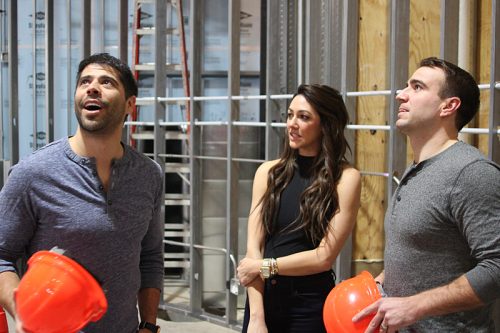
So you talk about these systems, but if I was somebody in the business for a long time, I’d say, you can look at all these reports but ultimately, somebody’s gotta be walking the floor. Somebody’s gotta be talking to customers, seeing if they’re happy they’re there.
KARA: I think that we’re extremely aware that we’re opening this for our guests. They’re the ones that we’re creating it for and they’re the ones who are going to keep the doors open. That’s something that has always been number one for us and something that we’re really excited about—that kind of people interaction and exposure and connection.
I think when we talk about these systems and this technology and what we bring to the industry, that’s kind of us explaining how we’ll stand out—
FRANK: And the technology will put people in a position to have the time and the freedom to do the things they need to be doing on the floor. If you set your staff up to succeed, and to have the time to go to the floor, and to have the training that they need to have, and have the freedom to do their job—that’s what we want to allow them to do, rather than the things you hear about where management gets bogged down in ridiculous back of house tasks—
KARA: Doing inventory for ten hours—
FRANK: And I think the simple answer is, every decision we make is based on guest experiences. From the way that you enter the building to how you’re greeted by the host to when you sit down, how your server interacts with you. Everything until they leave the restaurant, that is number one priority. And we have a lot of strong opinions about that, again, just things we’ve noticed from outside the restaurant industry—there’s things that we love and things where we’re like, “I can’t believe that’s how they provide their service.”
So more than systems, it’s how you create an overall culture for staff?
FRANK: Being young, being exposed to different types of businesses, being part of this millennial generation, we’re starting to see the culture shift toward more work/life balance. Employees of today’s world are wanting something much different than they wanted 30 years ago.
And so we’re really trying to focus on capturing as much of what these people are wanting today, and starting from the ground up and creating that culture within our business. We’re really trying to think of every single thing that we’ve either experienced ourselves, or heard of from other companies, friends, inside or outside of the restaurant industry, that worked for them, and really try to start with a great great culture from day one.
KARA: Especially in the restaurant world right now, where you see a lack of people in the pool to pull from because so many places are opening, and I think it’s very important to have a culture that people buy into and feel they’re a part of. That they feel is more than just a day to day job. I think it’s very important in this industry—and for us being a new group, both hiring and retaining staff it’s going to be huge for us to have a culture that people want to be part of.
So say things go well, and you’re looking at restaurant number two a year or two down the road. Will it be in the West Loop? Are you a West Loop group now?
KARA: We’re excited to be part of the West Loop, and I think the opportunities there are kind of endless. But I don’t know that we’re a specific neighborhood type of group yet—I think that similar to what happened with the space here, the space, the location dictates the concept. So I think that if we have a concept in mind, that that’s what we’re going to do, then we may look to a neighborhood to facilitate that.
FRANK: We’re definitely not driven by geography. We’re excited by the industry, from a broad perspective, and really what drives us is concepts. We have a lot of other cool concepts that we’re excited about for the future, but the focus right now is that number one is right, that the systems are ready, and hopefully that will continue into some success in the future. But you gotta get one right, let’s not get ahead of ourselves.
Michael Gebert says all systems are go as editor of Fooditor.
Latest
Join the Discussion
After you comment, click Post. If you're not already logged in you will be asked to log in or register with Disqus.





